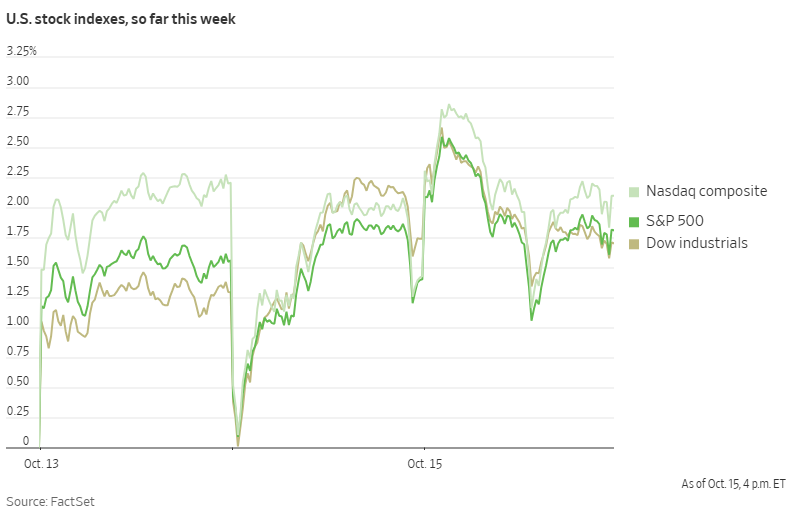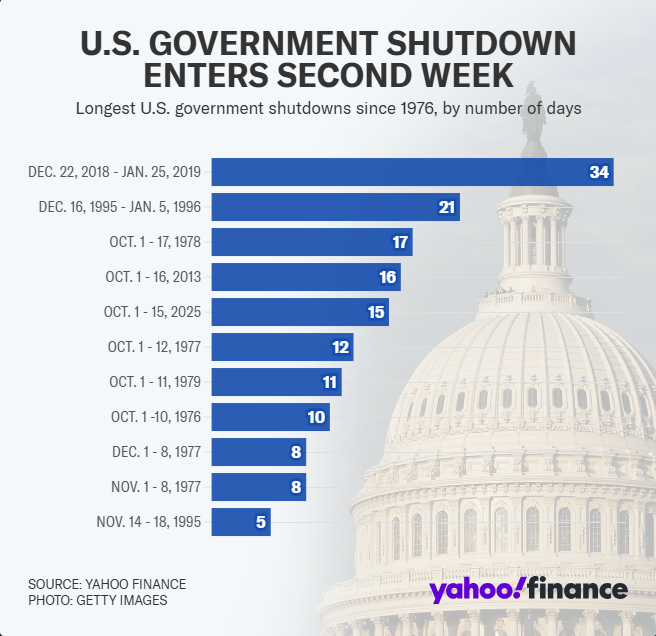市场资讯及洞察

S&P 500 and ASX Rally as Big Banks Drive Markets
Both the S&P 500 and ASX have rallied on the back of stronger-than-expected major bank earnings reports on both sides of the Pacific.
In the US, Bank of America reported a 31% year-over-year increase in earnings per share at $1.06, exceeding Wall Street's estimate of $0.95. Meanwhile, Morgan Stanley delivered a record-breaking quarter with EPS of $2.80, a nearly 49% increase from the same period last year.

On the Australian front, the benchmark ASX 200 leapt 1.03% to 8990.99, with all four major Australian banks playing a major role. CBA closed 1.45% higher, Westpac 1.98%, NAB 1.87%, and ANZ 0.53%.
These strong bank results indicate broader economic strength, despite recent concerns about US-China trade tensions. US Treasury Secretary Scott Bessent emphasised that Washington did not want to escalate trade conflict with China and noted that President Trump is ready to meet Chinese President Xi Jinping in South Korea later this month.
With the third-quarter earnings season just getting underway, these early positive results from financial institutions could prove as the start of continued market strength through to the end of the year.
U.S. Government Shutdown Likely to Last Into November
Washington remains gridlocked as the U.S. enters its 16th day of shutdown. With no signs of compromise on the horizon, it appears increasingly likely the shutdown will extend into November and could even compromise the Thanksgiving holiday season.
Treasury Secretary Scott Bessent has warned "we are starting to cut into muscle here" and estimated "the shutdown may start costing the US economy up to $15 billion a day."
The core issue driving the shutdown is healthcare policy, specifically the expiring Affordable Care Act subsidies. Democrats are demanding these subsidies be extended, while Republicans argue this issue can be addressed separately from government funding.
The Trump administration has taken steps to blunt some of the shutdown's immediate impact, including reallocating funds to pay active-duty soldiers this week and infusing $300 million into food aid programs.
However, House Speaker Mike Johnson has emphasised these are merely "temporary fixes" that likely cannot be repeated at the end of October when the next round of military paychecks is scheduled.

By the end of this week, this shutdown will become the third-longest in U.S. history. If it continues into November 4th, it will surpass the 34-day shutdown of 2018-2019 to become the longest government shutdown ever recorded.
This prolonged shutdown adds another layer of volatility to markets. While previous shutdowns have typically had limited long-term market impacts, the unprecedented length and timing of this closure, combined with its expanding economic toll, warrant closer attention as we move toward November.
Trump Announces Modi Has Agreed to Stop Buying Russian Oil
Yesterday, Trump announced that Indian Prime Minister Narendra Modi has agreed to stop purchasing Russian oil. He stated that Modi assured him India would halt Russian oil imports "within a short period of time," describing it as "a big step" in efforts to isolate Moscow economically.
The announcement comes after months of trade tensions between the US and India. In August, Trump imposed 50% tariffs on Indian exports to the US, doubling previous rates and specifically citing India's Russian oil purchases as a driving factor.

India has been one of Russia's top oil customers alongside China in recent years. Both countries have taken advantage of discounted Russian oil prices since the start of the Ukraine invasion.
Analysis suggests India saved between $2.5 billion to $12.6 billion since 2022 by purchasing discounted Russian crude compared to other sources, helping support its growing economy of 1.4 billion people.
Trump suggested that India's move would help accelerate the end of the Ukraine war, stating: "If India doesn't buy oil, it makes it much easier." He also mentioned his intention to convince China to follow suit: "Now I've got to get China to do the same thing."
The Indian embassy in Washington has not yet confirmed Modi's commitment. Markets will be closely watching for official statements from India and monitoring oil trading patterns in the coming weeks to assess the potential impact on global energy flows and prices.
Chart of the Day - Gold futures CFD (XAUUSD)


Why Is Gold in Focus Right Now?Throughout early 2025, gold has surged to record highs, breaching $3,400 an ounce for the first time in history. For newer traders, this may seem like a “blue-sky” breakout without precedent. For experienced market participants, it raises a more practical and important question, i.e. what is driving this rally, and is it sustainable?Understanding the fundamental and technical context behind such moves helps us not only trade the present but plan for what may come next, which can guide us in the decisions we make with our trading action.This article aims to build upon recent outlook webinars that we have delivered recently, which have waved the bullish flag throughout. However, I must admit to having been surprised at the velocity of the rally.We will try to unpick key drivers as well as analyse what could be next and why.What’s Driving the Gold Rally in 2025?Let’s take a look at the main contributing factors that are currently supporting the upward momentum in gold prices:1. Rising Global Uncertainty and Geopolitical RiskPolitical instability, as it has historically, remains a strong macro backdrop for gold. Recent flare-ups in geopolitical conflict — particularly in Eastern Europe and the Middle East — have returned “safe haven” flows back into focus. This is typical during periods when traditional risk assets like equities face greater downside volatility.Additionally, the somewhat turbulent start (even more so than many predicted) to the new U.S. administration has introduced an element of policy uncertainty, particularly around trade, inflation and the impact of economic growth. The possibility of further tariffs or fiscal tightening reinforces gold’s appeal as a form of protection.Key Point: Traders need to monitor not just existing conflicts, but also the market perception of risk. Gold often responds not to what is happening, but to what investors fear might happen.2. US V China – trade war brewing?Tariff dramas have been the major market chatter and sentiment changer over the last few weeks. On top of general broad international tariffs, and to pause or not to pause decisions, the major attention is, and likely to continue to be, the escalation of tariffs between the U.S. and China has pushed inflation expectations higher. While inflation has generally cooled since its 2022–2023 peaks, cost-push factors such as tariffs can reintroduce price pressures, particularly on imports.Central banks globally are including tariffs within a rate decision narrative, but no central bank is more in focus, of course, than the Federal Reserve. In Trump's last presidency, the current Fed chairman Jerome Powell came under fire for rate policy, and already, it was noteworthy that the current president aimed a shot at him once again. The market is aware that inflationary shocks are not off the table once tariff impact starts to bite at importer costs in the US, and the “priced in” rate cut that is likely to occur in June is still some time away, and the certainty that this may happen may start to waver. Gold has historically performed well when real yields (interest rates adjusted for inflation) fall or remain negative.Key Point: Watch CPI data closely. If inflation expectations start to climb again due to trade-related costs, gold may continue to benefit.3. U.S. Dollar WeaknessThe U.S. dollar index (DXY) has declined to multi-year lows, making gold more attractive to non-U.S. investors. This is a classic inverse relationship — as the dollar falls, gold often rises.A weaker dollar could potentially indicating that the market could be pricing in a more dovish Federal Reserve, with rate cuts potentially on the table later in the year, However, more likely in this case, the dramatic drop in the USD, which this week hit 3 year lows, is more likely due to concerns about growth and even the perceived chance of recession.At the time of writing, the earnings season is ramping up, and despite Q1 results so far being relatively positive, we are already seeing concerns expressed (as is often the case with uncertainty) relating to forward guidance. This, of course, plays into the slowdown narrative. This week's PMI data feels as though it may have even more importance than usual.Key Point: Gold traders should always include USD direction in their macro framework. It often amplifies or suppresses broader trends in the metal.4. Central Bank and Institutional DemandAnother major support for gold is the persistent demand from central banks, particularly in emerging markets such as China and Turkey. These institutions are increasingly shifting reserves into gold as part of long-term diversification away from USD assets.Evidence suggests ETF flows have also picked up, showing increasing but not outrageous levels, suggesting the move is still institutional in nature rather than purely speculative.Key Point: As long as institutional and central bank demand remains steady or rising, gold has a structural reason to be supported underneath current price levels.What the Technical Picture Is Telling UsWhile fundamental drivers continue to support gold, the technical setup also tells an important story — one that can help traders decide whether to stay in, take partial profits, or prepare for tactical re-entries after any price pullback. Let’s explore the technical picture in a bit more detail.
- Gold’s Long-Term Trend Structure Remains Intact
Gold has been making a consistent series of higher highs and higher lows since mid-2023. This trend has been confirmed across multiple timeframes, including the daily and weekly charts — an important feature for position traders.Currently, price is well above both the 50-day and 200-day exponential moving averages (EMA), which have now turned upward and widened — a classic sign of trend strength and directional bias. When prices pull back in strong trends, these EMAs often serve as dynamic support levels.
- Momentum: The weekly RSI is elevated (above 75), which suggests gold may be in overbought territory in the short term.
What About RSI Being Overbought?One of the most common misunderstandings among newer traders is how to interpret an elevated RSI (Relative Strength Index), particularly when it crosses above the traditional 70 level.RSI above 70 does not automatically mean 'sell' — especially in strong trends, so this merits a little further discussion.Here’s why a high RSI may not be a problem:
- Context matters: In trending markets, RSI can remain elevated (above 70 or even 80) for extended periods without any meaningful pullback. This is often referred to as a 'momentum breakout' condition.
- Confirmation from volume: If rising RSI is accompanied by increased volume, it suggests that momentum is being supported by participation, not exhaustion. Currently, weekly volume has expanded on breakout weeks, supporting the move.
- New highs with RSI > 70 are actually bullish: A strong market making new highs and registering overbought readings usually reflects strength, not vulnerability — unless divergence begins to appear.
Key Point: Use RSI as a momentum gauge, not a reversal trigger in isolation. In this case, RSI supports the idea that gold is strong, not yet stretched to the point of reversal.
- Next Targets: Many technical analysts are watching $3,500 and $3,650 as key psychological and Fibonacci extension levels. A sustained break above $3,400 would likely bring these into view.
- Support Levels: If price retraces, $3,200 and $3,050 are likely areas where buyers may step back in, especially if the macro story remains intact.Key Point: Momentum remains strong, but even in trending markets, corrections are normal. Having a plan for where to re-engage is just as important as knowing when to stay out.
- What Would a Healthy Pullback Look Like?
Even the strongest trends pause. If gold does retrace in the short term, the nature of the pullback is more important than whether it happens.Signs of a healthy pullback include:- Controlled decline in decreasing volume- Price respecting prior breakout zones — e.g., $3,250–$3,280- Holding dynamic support like the 20-day or 50-day EMA- Reversal candle patterns near support (e.g., hammer, bullish engulfing)Key Point: In strong markets, pullbacks are often shallow and short-lived. They can be opportunities to scale in, provided the structure remains intact.Sentiment and Positioning: Are Traders Too Bullish?It’s important not to get swept up in price action alone. The COT (Commitments of Traders) report can provide valuable insight into whether markets are approaching overly crowded levels.
- Large Speculators have increased their net long positions, but not yet at levels seen in major historical peaks.
- Retail traders have only recently started to increase exposure, which suggests the move is not fully mature.
- ETF inflows, while rising, are still below the aggressive flows seen in 2020.Key Point: Current positioning suggests there may still be room to run, especially if new catalysts emerge. However, if positioning becomes too lopsided, be ready for faster and sharper corrections.
What Could Change the Narrative….Risks to Watch?Even with a strong bull case, traders must stay aware of what could derail gold’s momentum:Risk Event #1: Sudden USD reboundImpact on Gold: Could trigger a sharp pullbackRisk Event #2: Hawkish Fed surpriseImpact on Gold: Logically higher real yields = bearish gold due to USD impact – however, gold’s role as an inflation risk is likely to offset this.Risk Event #3: De-escalation of trade/geopolitical tensionsImpact on Gold: Safe-haven demand may soften if this is part of the reason for the current price rise. However, with other factors predominating price moves for right now, again, this may not be critical.Risk Event #4: Profit-taking and reversal in momentumImpact on Gold: Could create a short-term topKey Point: Risk doesn’t always mean reversal — but it does mean adjusting trade size, stops, and expectations when conditions change.Summary: Stay Informed, Stay DisciplinedGold’s rise in 2025 has been impressive, but it hasn’t been irrational. The macro backdrop, institutional support, and technical structure all support the trend.However, markets rarely move in straight lines, and traders should stay ready for both continuation and correction scenarios.Success is likely to lie in applying consistency in the management of profit and capital risks, as well as having a clear method to re-enter as appropriate. consistently while remaining adaptable to changing conditions.Traders should view the current gold move as a reflection of persistent macro themes and technical support rather than any sort of “bubble”. Whether you’re already long or waiting for a retracement, your decision-making should be rooted in having a clear and unambiguous trading plan and, of course, the discipline of follow-through in the actions you take.


在全球科技巨头中,苹果(AAPL.)无疑是对国际政策环境变动最为敏感的一员。2025年4月初,美方再度释放对华经贸立场趋紧的信号,提出可能对部分中国产品加征更高关税。这一表态不仅震荡了资本市场,也再次将苹果推向了聚光灯下。关税冲击下的剧烈波动相关言论发布后,苹果股价自4月3日起出现剧烈震荡:连续下跌:在随后的四个交易日中,苹果股价累计下跌近23%,市值蒸发超6400亿美元,成为科技股中受影响最严重的公司之一。4月9日反弹:随着美方宣布对部分经济体实施90天的关税暂缓措施,市场一度重新燃起对苹果“豁免”的预期,苹果股价当天上涨15.33%,创下自1998年以来最大单日涨幅。随后回落:仅过了一天,4月10日苹果股价又下跌了6%,显示市场情绪依然动荡,担忧情绪未能根本缓解。4月15日再度回升:苹果股价上涨至202.52美元,单日涨幅2.24%,主要由于市场传出“智能手机类商品可能获得临时豁免”的政策缓和信号。这种剧烈波动反映出当前市场存在两种交织的情绪:一方面是对政策周期重演的高度警觉,另一方面是对“再次豁免”的隐含期待。印度:拯救苹果的新方案?据《华尔街日报》4月7日报道,苹果正计划大幅提高从印度出口到美国的iPhone数量,以规避新一轮关税的冲击。当前从印度出口至美的关税远低于中国,若将当地产能充分释放,理论上可满足美国市场近50%的iPhone需求。这被视为苹果“全球产能多元化”战略的一部分,但印度的制造基础设施与整体效率仍难在短期内全面替代中国,苹果仍面临较高的过渡与调整成本。

“搬回美国”?梦想尚远将制造环节迁回本土虽有政策层面支持,但现实中障碍重重。彭博社4月6日指出,美国本土的高劳动力成本使制造业大规模回归面临挑战。更关键的是,新建产能通常需时4至5年,远水难解近渴。在可预见的未来,苹果大致面临三种应对路径:自行吸收关税成本,影响利润率;将成本部分转嫁至消费者,提高售价;加快全球产能多元化布局,重构供应链体系。“特赦幻想”:市场在赌什么?回顾2018年,美方对中方加征关税期间,苹果曾获得部分产品(如Mac Pro组件)的豁免权。这段历史如今被市场重新提起。不少分析师指出,苹果近期股价反弹背后的一个关键逻辑,就是投资者在押注其有望再次获得类似“特别通道”待遇。而苹果近年来在美本土的投资承诺,以及在当地就业带动方面的权重,也为这一设想提供了现实依据。尽管目前暂无任何正式公告确认豁免安排,但市场对潜在利好已有较强预期。不过,也需警惕:一旦豁免落空,短期波动恐进一步加剧。

风口上的苹果苹果如今既是全球化进程的直接受益者,也是其结构调整过程中的核心焦点。近期的关税相关言论,再次提醒市场参与者:全球产业链的演变不只是经济问题,更涉及多元因素的综合博弈。笔者认为,“特赦”当然存在可能,但更多是一种短期缓冲机制。中长期看,苹果仍将不可避免地面对供应链架构的深层次重构。免责声明:GO Markets 分析师或外部发言人提供的信息基于其独立分析或个人经验。所表达的观点或交易风格仅代表其个人;并不代表 GO Markets 的观点或立场。联系方式:墨尔本 03 8658 0603悉尼 02 9188 0418中国地区(中文) 400 120 8537中国地区(英文) +248 4 671 903作者:Yori Yu | GO Markets 悉尼中文部


每个套路的形成在之前都会在不断地重复,而当大家都在深信每个套路而采取相同行动的时候,就是套路的破灭。目前,美股有一种套路十分显见——急跌缓涨,熊短牛长。回顾历史:2008年金融危机,标普500指数自高点暴跌50%,5年后,指数抹掉全部跌幅,并创新高。2020年,疫情爆发,美股四次熔断,一月内暴跌超20%,但之后快速上攻,半年后续创新高。2022年,受战争和通胀影响,美股经历大幅回撤,但仅过一年修整,美股又继续不断刷新高位。由此可见,面对各种危机,美股似乎总能凭借其强大的韧性和调整能力,从困境中逐步摆脱困扰,并重新回到增长的轨道上。无论是金融危机、贸易摩擦、政策变动,还是全球经济波动,美股总能找到突破困局的办法,吸引投资者的信心重新回升。基于此,很多市场观察者和投资者倾向于认为,当前的危机大概率也会以类似的方式得到缓解。虽然短期内市场可能仍会经历一段不确定性,但随着关税政策的逐步明朗和市场对经济基本面的重新审视,美股可能会迎来新一轮的反弹,走出目前的阴霾,重新回到增长的正轨。因此,许多投资者正准备在市场极度恐慌时刻抄底,希望借反弹获利。但笔者认为,事情恐怕没这么简单。

就仅从简单朴素的二八定律来看,市场上总是赔多赢少。二八定律,即80%的投资者往往只能分享市场20%的收益,而剩下的20%的投资者则能够分到80%的利润。这一规律反映了市场中赢家和输家的巨大差距。如果每个人都能在抄底时获得盈利,那市场的资金流动将变得极其不平衡,最终谁来赔钱呢?在实际操作中,未来市场如果出现长周期级别的震荡向下,投资者面临的风险则更加明显。在市场下行趋势中,如果抄底的位置不合适,投资者可能会遭遇资金长期被套牢的局面。此外,市场上的震荡下行往往不是单纯的下跌,而是伴随着剧烈的波动。在这种环境下,投资者可能很难抓住反弹的时机。

再来说基本面,全面加征关税可能意味着全球化时代的结束,这一转折必然会对国际贸易和资本流动的格局产生深远影响。全球化作为经济发展的核心驱动力之一,促进了商品、服务和资本的自由流动,带来了全球各国之间更加紧密的经济合作。然而,随着美国对外贸易政策的日益收紧,尤其是加征关税等保护主义措施的实施,全球化的进程受到严重挑战。对于美股而言,先前的上涨逻辑在很大程度上依赖于全球化带来的红利。美国作为全球经济的核心之一,其股票市场的繁荣不仅得益于国内经济的增长,也与全球资本流动、国际市场的需求以及跨国企业的全球布局息息相关。然而,如果全球化进程停滞甚至倒退,未来美股的增长逻辑就需要进行相应的调整。因此,反弹路径应该不会像大家想的那么简单。市场通常在面临重大变局时,反弹往往会受到诸多复杂因素的影响,而不是单纯的按照以往的模式进行。在这种环境下,投资者应当意识到,反弹并不是绝对的,也不一定会按照预期的时间和幅度出现。在操作之前,建议适度考虑套路改变的风险。联系方式:墨尔本 03 8658 0603悉尼 02 9188 0418中国地区(中文) 400 120 8537中国地区(英文) +248 4 671 903作者:Michael Miao | GO Markets 悉尼中文部


Why have a Trading Plan? We all know that markets can be chaotic, unpredictable, and emotionally wearing when you are trading. Without a structured approach, even experienced traders can find themselves making impulsive and often poor decisions, both on entry and exit, that lead to significant losses and cap any potential profit.A trading plan serves as your personal roadmap for trading financial markets—a set of rules and guidelines that dictate your trading behaviour in varied market conditions irrespective of which instruments or timeframes you are trading. Think of your trading plan as the foundation of your trading business. It can provide clarity, consistency in action, and the basis for improvement in outcomes (through measurement and refining). These are all crucial for long-term success in trading.This article aims to address some of the key principles of trading plan development and usage. For those less experienced, use it as guidance to get you started. For those of you who are a little further down your trading journey, here is a refresher and checklist to make sure you have what you need in place.Common Mistakes Traders Make (And How to Avoid Them)Mistake #1: Trading Without a PlanProblem: Many traders enter the market with nothing but hope and excitement, treating trading more like gambling than a strategic business venture.Solution: Commit to never placing a trade that is not consistent with your written plan on entry AND exit. Even a simple plan is better than none at all. Start with basic rules about entry criteria, position sizing, and risk management and then add to it from there.Mistake #2: Creating an Overly Complex PlanProblem: Some traders create plans so intricate that they become impractical to follow in real-time trading conditions in the heat of the market.Solution: Your plan should be comprehensive enough to cover all scenarios but simple enough that you can make decisions and take action on key points under pressure. You should only use indicators on your plan that you understand, i.e. what they are telling you about the chart you are looking at. Mistake #3: Failing to Define Risk GuidelinesProblem: Without clear risk guidelines, traders often take positions that are too large relative to their account size. Failing to recognise this may lead to catastrophic losses or giving back significant profit from trades that go in your direction.Solution: Establish strict risk-per-trade rules, e.g. x% of account size (many professionals never risk more than 1-2% of their capital on a single trade). Define maximum drawdown levels that would trigger a trading pause or strategy review.Mistake #4: Not Adapting to Changing Market ConditionsProblem: Market conditions constantly change, and a strategy that worked last year might not work today.Solution: As part of your performance evaluation, it would seem logical to include a reference to a market type, e.g., bullish, bearish, choppy, or volatile. Through recording this, it may be possible to recognise which markets are the best fit for a specific strategy (and, of course, those that are not).Mistake #5: Ignoring the Psychological Aspects of TradingProblem: Trading psychology often determines success more than technical knowledge, yet many plans focus exclusively on entry and exit rules.Solution: Incorporate psychological safeguards into your plan. Identify your emotional triggers and articulate in your plan some rules for when you should and shouldn't trade, e.g. when unwell or having a succession of losses. It is always good practice to take a break from trading intermittently.Step-by-Step Guide to Creating Your Trading PlanStep 1: Select Your Markets and TimeframesNot all markets or timeframes will suit your personal circumstances or risk profile, so defining:
- Which markets match your interests, knowledge, and available trading hours?
- Will you be a day trader, swing trader, or longer-term position trader?
- What specific timeframes will you focus on for analysis and execution?
Many successful traders may ultimately specialise in specific sectors or instruments where they've developed an understanding of what creates price movement and what may happen next, rather than trying to trade everything. This will obviously take time but is worth some consideration if you find you are excelling in certain conditions. Step 2: Develop Your Trading Strategy This is the core of your plan, describing exactly how you'll identify and execute trades:Market Analysis Methods:What you use to help make trading decisions is at the basis of any strategy. There are a number of tools you can use, such as technical indicators (e.g. moving averages, RSI, MACD, etc.) and chart patterns you'll look for (head and shoulders, double tops, flag patterns). Fundamental factors you'll consider (earnings reports, economic data releases, sector trends) are all classic examples.Entry Rules:These are specific conditions that must be met before entering a trade. These MUST be unambiguous and objective, often a set of criteria statements that cover EVERY element of your trading decision making.
- This will often consist of statements about price action, candle structure and patterns used. Additionally, a series of confirmation signals that are usually required will be outlined (e.g., volume confirmation above a longer-term moving average) as well as a news event filter (whether you'll trade around major announcements) and perhaps the time of day.
Each of these requires a separate statement. Exit Rules:
- Profit target methods (fixed points, e.g. X ATR multiple, technical levels, e.g. next resistance if in a long trade, and the use of trailing stops)
- Stop-loss placement strategy (volatility-based, e.g. X ATR below entry, support/resistance based)
- Partial profit-taking rules (scaling out at specific targets)
Be exceedingly specific in your strategy. For example:
- Enter long when price closes above the neckline following a reverse head and shoulders
- Price is over the 50-day EMA
- RSI is between 40-60 (indicating potential momentum shift)
- Volume is increasing from the previous bar
- Place stop-loss at the most recent swing low
- Trail a stop using the 20EMA
- Your strategy should also address different market conditions. A strategy that works in a trending market may fail in a ranging market. Consider creating decision trees for various scenarios you might encounter.
Step 3: Establish Risk and Money Management RulesThis section protects your trading capital and is arguably the most critical part of your plan:
- Maximum risk per trade (ideally 0.5-2% of total capital)
- Position sizing formula based on stop distance (e.g., Risk Amount of account capital ÷ Stop Distance = Position Size). At an advanced level, you could look to tie this to an objective strength of signal measure and adjust accordingly.
- Maximum correlated exposure (e.g., no more than 2 trades of FX pairs when one of these includes USD)
- Maximum account drawdown before taking a break (e.g., 10% drawdown triggers a trading pause)
These rules should be non-negotiable and followed rigorously, regardless of how confident you feel about a trade.Step 4: Create Your Trading Routine There is no doubt that consistency breeds success in trading:
- Pre-market routine (what analysis you'll do before trading)
- During market hours (how you'll monitor positions, what would trigger new entries)
- Post-market review (how you'll record and analyse your trading day)
- Weekly and monthly review processes
A structured routine eliminates many decision points that could otherwise lead to impulsive actions.Step 5: Plan for Continuous ImprovementYour growth as a trader SHOULD never stop (although many traders fail to progress). make sure that you have a system in place for making sure you DO :
- How and when you'll review your trading performance
- Metrics you'll track to evaluate success, e.g. Net profit, drawdown, win rate, average win/loss
- Education resources you'll use to improve
- Benchmarks for advancing to larger position sizes or new strategies
Step 6: Document EverythingCompile all the above elements into a written document and, of course, have a trading journal to assist in the evaluation of performance.Within this, don’t forget to include some reference to how you are feeling, what you need to work on and what learning could be next for you.Step 7: Putting Your Plan into Action Having a plan is only the first step—consistently following it is what separates successful traders from the rest. Here are some tips for adherence:
- Keep it visible: Post a summary of your trading rules where you can see them while trading.
- Use checklists: Create pre-trade checklists to ensure you're following your plan for each trade.
- Automate where possible: Use technology to enforce discipline (preset stop-losses, position sizing calculators).
- Accountability partners: Consider sharing your plan with a trusted trading friend who can help keep you accountable.
- Reward compliance: Develop a system to reward yourself for following your plan, regardless of the trading outcome.
Remember, the success of a trade is not measured by profit or loss but by how well you adhered to your plan. A losing trade that followed your rules is actually a success from a process perspective, and adhering to your plan despite singular losses is more likely to result in better outcomes over a succession of trades.Conclusion A well-crafted trading plan transforms trading from a stress-inducing gamble into a structured business operation. While markets will always contain an element of unpredictability, your response to them doesn't have to be unpredictable.Take the time to develop a comprehensive plan that reflects your goals, resources, and personality. Then commit to following it with discipline. In the words of legendary trader Paul Tudor Jones, "Don't focus on making money; focus on protecting what you have." A good trading plan does exactly that—it protects you from yourself and the market's inevitable uncertainties.Your trading plan is a living document that will evolve as you grow as a trader. The process of creating and refining it is itself a valuable exercise that will deepen your understanding of the markets and your relationship with them.


Global markets continue to search for anything they can grasp onto that points to possible signs of progress on global trade tensions, and by anything, we do mean ‘anything’ – truth social posts, X posts, this person heard from this person something tangible. It shows just how volatile this current market really is that inuendo and whim is being treated as fact.Back in the ‘tangible’ real world, the other white knight that is being watched ever closely is some form of possible policy backstop from central banks - Particularly the Federal Reserve. Considering the President’s consistent input here that US rates should be lower either through a post or a media rant, so far this has not moved the Fed one inch.While the recent 90-day tariff pause from Liberation Day has provided a temporary market reprieve, the underlying trade tensions, especially between the U.S. and China, remain largely unresolved. In fact, we would argue they are only getting stronger as nations and blocs are now looking to each other to offset the US trade impasse.China remains the most consequential player in this landscape, and despite the pause, the effective U.S. (weighted-average) tariff rate on goods has only fallen modestly, just 3%, from a 24% peak to 21% year-to-date.Beijing appears to be holding the ‘better hand’ currently; the additional back down from Washington with its ‘exemption’ on electronics is case in point. Just take Apple as the example, down over 23% since its peak in December last year, and it is the poster child for the full impact of Trump’s program. This back-down is showing just how much strain the US is experiencing with Beijing playing hardball.Think about it: a US$3,000 iPhone versus a Samsung that, even with tariffs, could be as much as 20% less for the US consumers. That’s a killer for the Silicon Valley Titan and Trump’s plan on the whole.This just shows the structural nature of the U.S.-China trade imbalance and the scale of bilateral tariffs already in place.As negotiations remain tentative and tensions persist, the market is left navigating a landscape shaped by potential escalation, geopolitical signalling, and the lingering question of whether or even what policymakers will/can do if economic or market stress intensifies.China: Market KingmakerAs mentioned, the modest drop in the effective tariff rate even after a 90-day pause highlights the entrenched nature of the dispute. The sheer scale of U.S.-China trade means that even minor changes have significant global implications. While no breakthrough appears imminent, traders and investors alike continue to watch for any sign of constructive engagement – which currently does not exist, if we are honest.Any sign of negotiation could take place, or even if there is a modest de-escalation, it could trigger a risk-on response across asset classes as seen in the final part of the week beginning 7 March 2025. This is why China is now the market kingmaker – it is currently holding firm on ‘escalating’ when responding to Washington’s moves.The indicator we all need to watch for around US/China relations is US Treasury Bonds. Any sign that Beijing is turning from escalation to de-escalation should produce a rally sharply here as market flows have been dominated by heightened cash preference as persistent stagflation concerns, coupled with recession risks.Where’s the Fed at?Will the Federal Reserve step in to support markets? The better question is, can it step in? From a traditional standpoint with rate cuts – no. However, there are other mechanisms like exemptions to the Supplementary Leverage Ratio (this is the amount of tier one capital required to be held at US banks), which was temporarily introduced during the 2020 pandemic crisis. A repeat of that policy would increase the banking system’s capacity to absorb government bonds without triggering capital constraints.More aggressive tools, such as direct purchases at the long end of the U.S. yield curve, are considered much less likely in the current macro environment, and Fed officials have been cautious in their recent commentary around this idea.Realistically, there are limited signs of funding stress and a relatively high threshold for intervention; the probability of a "Fed put" being activated near-term appears low to non-existent. This means the Fed is just as much a spectator as we are.The FX flowWith US exceptionalism now on the blink, the broader trend of US dollar weakness is expected to persist, but the weak spots may change.Rather than concentrating on current account surplus currencies such as JPY and CHF, the weakness may broaden out to risk-sensitive FX like AUD, NZD, and CAD. Just take a look at the bounce back in AUDUSD at the backend of the 7 March week’s trading – a 3.8% jump in 2 days is unheard of.The euro is expected to perform well across both “risk-on” and “risk-off” tariff scenarios, driven by long-term capital reallocation and structural factors within the euro area.We need to highlight Japan and South Korea – both nations have shown signs they are willing to engage with Washington, and the response from the market was huge. More importantly, the administration has responded positively. This puts JPY and KRW in a more positive light than peers, and they would be wary of being exposed as a deal would put them into upside air very quickly.Outlook: Cloudy but clearing – chance of tariff showers later in the week.Markets remain in a holding pattern, waiting for clearer signals on trade policy.The recent softening of rhetoric from the U.S., particularly in response to financial market volatility, suggests some room for constructive negotiations—especially with countries outside China.The 90-day pause has provided some breathing space, but it will need to be followed by tangible progress if market sentiment is to turn, and on that metric, the outlook is still cloudy but clearing. Yet tariff risks retain high later in the period as the 90-day period looks to expire and specific tariffs (healthcare, electronics, etc) get announced.


近日,中美经贸政策变化再度引发市场高度关注。但桥水基金创始人达利欧指出,真正主导市场方向的并非关税本身,而是全球金融系统中更深层的结构性变量。他强调,全球债务周期、货币政策非对称、技术与资本重组,才是决定未来十年资产定价逻辑的“真正力量”。本文将围绕这四大系统变量,结合黄金、汇率、原油与股市表现,梳理2025年当下值得关注的核心风险与配置逻辑。一、结构性压力积聚:政策调整只是表象4月9日,美国总统特朗普宣布对中国出口商品实施新的加征措施,整体税负提升显著。随后,中国国务院关税税则委员会宣布对原产于美国的全部进口商品在现有关税基础上加征50%关税。来自央视新闻与参考消息的报道显示,此举意在回应前期不对等行为,并维护国内产业安全。然而,桥水基金创始人雷·达利欧强调:“经贸摩擦只是表象,真正主导市场结构的,是全球系统性失衡的深层变量。”全球当前正面临三大核心结构错配:• 债务结构恶化:国际金融协会(IIF)数据显示,2023年全球债务总额已突破307万亿美元,多个主要经济体债务/GDP比创新高;• 政策分裂放大波动:美国两党在贸易与财政政策上的分歧日益明显,美联储数据显示,高净值人群掌握财富比例持续上升,分配结构失衡;• 技术冲击改变产业逻辑:高盛预计,未来十年生成式AI将影响超过3亿个工作岗位,技术、资本与劳动力关系正在重构。上述力量的叠加,使得资本市场对宏观变量的敏感度持续提升,政策信号一旦出现边际变化,资产波动往往随之加剧。达利欧在近期演讲中指出,当市场因关税而剧烈波动时,更应关注背后的“隐性变量”——即结构性债务失衡与地缘资本割裂正在形成系统性风险土壤,而政策只是表象。“在波动中寻找本质,是宏观投资者最重要的能力。”二、避险资产表现分化:风险偏好结构重估黄金:高位震荡中具备配置价值受宏观不确定性、避险情绪与全球央行购金共振影响,黄金在4月中旬突破每盎司3240美元的历史新高,随后震荡至3236美元附近。技术面显示,3000美元下方支撑较强,3200美元构成关键阻力。中期来看,若美联储进入降息窗口,黄金仍具备战略配置价值。日元:避险回流增强短期韧性美元指数短线下挫约3%,避险资金阶段性流向日元,推动美元兑日元汇率跌至120区间。日本央行削减长期债券购买,利差缩小强化了日元的阶段性支撑。不过,日元升值若过快仍可能引发干预预期,操作上宜轻仓防御为主。原油:结构性承压,短线反弹动能有限WTI油价自4月初以来持续回落,目前接近61.50美元/桶,布伦特价格回升至64.76美元。全球制造业疲弱、OPEC产量预期不稳、能源结构转型加快,均构成油价反弹压力。市场普遍认为短期存在波段修复可能,但趋势性反转尚需基本面支持。股市:情绪波动加剧,结构分化显现在全球经济和政策不确定性背景下,美国股市近期呈现出较大波动。部分科技股此前曾出现明显回调,但近日强劲反弹:4月11日纳指上涨2.06%,标普涨幅1.81%。这反映出部分领先企业凭借长期基本面优势正在吸引资金回流。• 领先科技股:虽然经历短期调整,但长期来看,这些公司依然具备技术创新和盈利成长优势。近期反弹显示市场对其未来走势的信心修复。• 其他板块:受宏观经济和政策分歧影响,部分传统板块依然表现疲软,波动性较高。总体而言,尽管短期内美国股市整体情绪存在波动,但部分领先科技公司的基本面依旧强劲,市场对其未来预期仍较乐观。投资者在关注整体走势的同时,应重点注意板块分化及个股基本面的变化,灵活应对短期波动与长期投资机会。在估值与盈利能力重新平衡的过程中,指数走势将更加震荡,建议投资者降低对大盘趋势的依赖,转向布局高现金流、政策支持明确、与内需相关的结构性板块。例如:基础设施数字化、能源设备制造、部分海外收入占比较高的出海企业。三、全球政策与市场预期重估中美关税博弈在4月中旬再度升级,但局部出现了短暂的缓和迹象。中方明确表态“将视美方行动而定”,保留对话窗口;美方则在实施125%“对等关税”的同时,于4月11日临时宣布豁免智能手机、笔记本电脑、路由器等20余类消费电子产品的关税。这一举措由美国海关与边境保护局(CBP)发布公告确认,被外界解读为应对国内通胀和消费压力的策略性回调,也成为当前局势下极少数的“温和信号”。然而,豁免之外,更强硬的政策也在同步推进:白宫已启动针对半导体、关键芯片、存储设备和高性能计算设备的国家安全调查,预计将在未来30~60天内公布一批以“保障供应链”为名义的新关税措施,或对现有豁免产品重新施压。这意味着,尽管部分产品暂时从高税率清单中撤下,但高科技领域面临的系统性壁垒反而正在筑高,中长期政策方向仍偏向收紧。中方则以等比反制方式,将对美商品关税水平同步提高至125%,并公开表示“对零和游戏不抱幻想”。与此同时,全球宏观数据持续释放疲弱信号:• 多国制造业PMI重回荣枯线下方;• 美国失业率升至4.2%;• 高盛下调标普500指数年内目标,IMF则发布全球增长预警。在此背景下,市场对主要央行“提前降息”预期升温,资产价格的未来方向将更多由流动性重估而非单一事件推动。这场由关税触发的连锁反应,正在验证达利欧长期以来的判断——全球已步入“结构错配与再均衡”的深周期阶段。贸易政策只是显性变量,真正影响未来定价框架的,是结构性债务、资本流向与全球产业链的再编排。四、资产配置建议:结构变化下的风险锚定面对大周期演化与政策转折重叠,建议投资者从结构与宏观角度出发,构建更具弹性与防御性的资产组合:• 黄金方面,避险属性与政策预期双支撑,使其在回调后具备较好性价比。建议关注2950–3000美元区域的分批布局机会;• 日元短期受益于避险资金流入与利差收窄,具备一定策略性价值。建议轻仓、短期参与;• 原油短期技术上超跌,但整体结构偏空不改,建议仅在库存数据或政策明确支持下进行波段型配置;• 股市方面,受估值高位与盈利预期下行双压,整体方向性不强。建议降低对指数的集中暴露,转向现金流稳健、估值合理、受益政策预期的行业,如高端制造、数字基建与出海平台。五、结语:越是波动,越需理解大逻辑达利欧所提出的“结构优先”理念提醒我们:投资不能只看表面现象,更应洞察驱动变化的底层力量。当前全球正在经历经济模式、政策逻辑与技术结构的深度重组,只有回归宏观判断,才能在震荡中找准方向。参考资料• 国际金融协会(IIF)《2023全球债务统计报告》• 美联储FRED数据库《家庭财富结构数据》• 高盛《AI与全球就业结构变化研究》• 新华社、央视新闻关于中美关税声明全文• 彭博社、路透社、IMF关于市场解读的最新报道• Eastmoney证券时报,美国宣布部分商品免征“对等关税”• 半岛电视台中文网,特朗普政府豁免智能手机和电脑等产品对等关税• 金杜律所,美国对华一系列关税新政影响及应对初探联系方式:墨尔本 03 8658 0603悉尼 02 9188 0418中国地区(中文) 400 120 8537中国地区(英文) +248 4 671 903作者:Kara Yang | GO Markets 悉尼中文部

